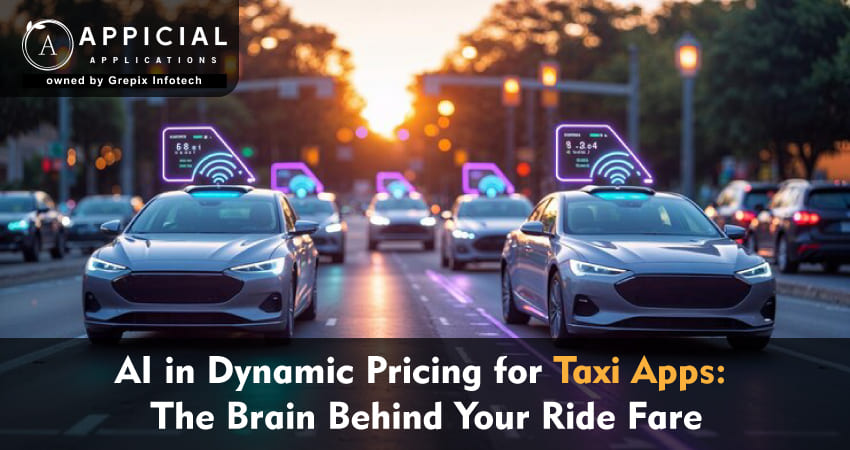
AI in Dynamic Pricing for Taxi Apps: The Brain Behind Your Ride Fare
It’s a rainy evening. You’re leaving work late, phone in one hand, the other waving down an app. You need a ride. You open the app, check the fare and it’s higher than usual. What gives?
That, right there, is dynamic pricing in action.
But here’s the thing: that fare wasn’t just picked out of thin air. It was carefully calculated by algorithms trained to predict what you, the driver, and a hundred other people nearby might do in the next ten minutes. There’s a brain behind the scenes, and that brain is artificial intelligence.
Yes, AI in taxi apps has officially taken the wheel when it comes to pricing. And while people often frown at price spikes, the truth is, AI is making fare management smarter, more efficient, and surprisingly fairer for everyone.
So let’s dig in. We’ll look at how AI is reshaping dynamic pricing, how surge pricing differs from smart fare, what it takes to implement this technology, why it matters to both riders and admins, and we’ll wrap up with some real-world examples. Stick around, we’ll even let you in on who’s building the best AI driven taxi apps today.
This in-depth blog explores the powerful role of artificial intelligence in transforming dynamic pricing for taxi apps. It breaks down how AI in taxi apps goes beyond traditional surge pricing, introducing more nuanced and responsive smart fare systems. From real-time demand prediction to personalized pricing and optimized driver incentives, AI is reshaping how rides are priced and delivered. The article also highlights successful case studies from Uber, Ola, and Grab, and concludes by recommending Appicial Applications as the go-to partner for building custom AI-driven taxi solutions.
How AI is Used in Pricing
Let’s get the basics straight. How does AI get involved in pricing at all?
Taxi apps have millions of data points flowing through them every second—locations, requests, driver status, traffic reports, the list goes on. AI thrives on data. It processes this massive information stream and decides, in real time, what a ride should cost.
Here’s how it plays out:
- Demand vs. supply: The app checks how many people are requesting rides and how many drivers are available. Simple economics.
- Location relevance: AI maps out hot zones concerts ending, bars closing, sports stadiums emptying and adjusts pricing accordingly.
- Time of day: Midnight on New Year’s Eve? The algorithm knows it’s a peak window.
- Weather influence: Rainy day? High chance more people will opt for a ride rather than walk or wait for public transport.
- User habits: Over time, the AI learns. If you usually take a cab from the same coffee shop every morning, it knows to expect your request.
The result is a fare that tries to match your personal needs, the availability of drivers, and the pulse of the city. Without AI, this level of personalization and precision wouldn’t be possible.
Surge Pricing vs. Smart Pricing
Now let’s talk about the two flavors of dynamic pricing you’ve probably seen or felt in your wallet.
What is Surge Pricing?
Most people know this one. It’s the classic model where fares spike when demand outpaces supply.
You open your app after a concert. Suddenly, the usual $8 ride is now $22. That’s surge pricing.
It’s a bit crude, honestly. While it does encourage more drivers to get on the road (since they earn more per trip), it often leaves riders annoyed. It doesn’t always reflect real-world subtleties. It reacts rather than thinks.
Enter Smart Pricing (a.k.a. Smart Fare)
Now, smart fare is what happens when you let AI do the thinking.
Instead of hiking prices across the board, smart pricing uses dozens of data points to adjust fares surgically:
- Is traffic easing up?
- Are drivers already en route to that busy zone?
- Is the surge really needed, or just a temporary glitch in the system?
AI can spot the difference between an actual surge in demand versus a fluke. It can also adjust fares downward in underutilized areas to encourage more ride requests.
In essence, surge pricing is the hammer; smart fare is the scalpel. And the latter is what forward-thinking taxi apps are embracing today.
Implementation: Behind the Scenes of AI-Based Dynamic Pricing
So, how do developers bring this all to life? Let’s pull back the curtain a bit.
Step 1 Data Gathering
The app collects live data constantly:
- Who’s opening the app?
- Where are they?
- How many drivers are logged in?
- What’s the traffic situation?
- Any big events nearby?
Without this data, AI has nothing to work with.
Step 2 Pattern Recognition
AI doesn’t guess, it learns. It studies past events: When were fares too high? When did drivers cancel rides too often? What times of day see the most activity?
Over time, these patterns teach the system how to react to similar situations in the future. Think of it as building a memory.
Step 3 Real-Time Decision Making
This is where AI shines. Unlike human managers who might need hours to crunch numbers, AI adjusts pricing in seconds. It runs predictions, evaluates variables, and updates fares instantly.
It’s this ability to adapt in the moment that makes AI in taxi apps such a game changer.
Step 4 Feedback and Tuning
No model is perfect from day one. AI systems improve through constant feedback. If a pricing change leads to fewer bookings, the system notes that. If it results in more driver logins, that’s a win.
The algorithm gets smarter with each ride literally.
Benefits: What’s in it for Riders and Admins?
So why should you, the end-user or the app owner care about all this?
Let’s break it down.
Riders (and Drivers, Too)
- More fairness: You won’t get hit with arbitrary price hikes. AI pricing has context.
- Better availability: Smart incentives bring more drivers online when they’re needed most.
- Shorter wait times: With real-time adjustments, you spend less time watching that car icon spin.
- More trust: When pricing is consistent and logical, people feel less like they’re being ripped off.
Admins and App Owners
- Higher revenue: AI helps maximize profits by finding the perfect balance between cost and demand.
- Operational efficiency: Less manual involvement in adjusting prices or dispatching drivers.
- Customer satisfaction: Happy users = higher retention.
- Scalability: As your app grows, the AI scales with you, managing complex markets automatically.
AI isn’t just about making things faster, it’s about making things better for everyone involved.
Case Studies: AI Pricing in Action
Still not convinced? Let’s look at some real-world examples where AI-powered pricing models are driving results.
Also Read: Mastering Push Notification Strategies for Taxi Apps: From Alerts to Engagement
Uber
Uber practically wrote the book on surge pricing, but even they’ve evolved. Today, they use AI to anticipate demand rather than just react to it. Their pricing system considers local events, rider behavior, and historical trends to fine-tune rates.
They’ve found that smart fare adjustments keep more drivers active and reduce the number of canceled rides. That’s a win-win.
Ola (India)
Ola implemented an AI-driven fare system that adjusts prices based on real-time driver availability and traffic congestion. Their AI even nudges users to opt for pooled rides when it makes economic sense, reducing wait times and improving route efficiency.
Grab (Southeast Asia)
Grab’s pricing engine uses AI to account for weather disruptions, public transport outages, and even political protests. Their local knowledge + AI approach has helped them keep fares fair in countries where consumer sensitivity to price is high.
Thinking of Building a Taxi App? Use Appicial Applications
If you’re considering entering the ride-hailing market, don’t start from scratch. Use the experts.
Appicial Applications is one of the top developers globally when it comes to custom AI taxi apps. Their platforms come pre-equipped with dynamic pricing logic, smart fare systems, and real-time dispatch.
What makes them different?
- Tailored development: Your app is customized to your market, your users, and your goals.
- Scalable architecture: Whether you’re launching in one city or ten, the app keeps up.
- Built-in AI tools: No need to integrate external systems AI is baked in.
- Full support: From development to launch and beyond, they’re with you.
So, if you’re dreaming of launching the next big thing in mobility, this is where you start. With brains, beauty, and the tech to back it up.
Final Thoughts
Pricing used to be simple: base fare + distance + time. But cities aren’t simple. Rider behavior isn’t simple. And supply-demand relationships definitely aren’t simple.
That’s why AI makes sense.
AI in taxi apps transforms dynamic pricing from a blunt-force tool into a finely-tuned engine that adapts to the world around it. Whether it’s surge pricing during a flash storm or a smart fare in a quiet suburb, the goal is the same fair pricing that works for everyone.
And if you’re building that next-gen ride app, there’s one team to trust: Appicial Applications.
They don’t just build apps. They build the future of mobility.
Looking out to start your own venture like Uber ? Try out our HireMe Taxi Uber Clone, the easiest way to kick-start your taxi business.Author's Bio

Vinay Jain is the Founder at Grepix Infotech and brings over 12 years of entrepreneurial experience. His focus revolves around software & business development and customer satisfaction.
Back to blog list




